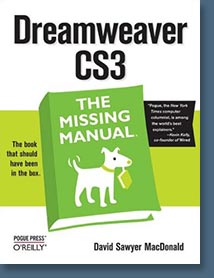
When I transitioned from GoLive to Dreamweaver CS3 I found a great book that totally guided me along. The book, Dreamweaver CS3: The Missing Manual, is available from Amazon.com at a 34% discount. I also have a free sample chapter you can download in PDF format. Here's a little bit more about the book, and then a brief description of the PDF sample chapter.
Welcome to Dreamweaver CS3. This new version of the popular web design software offers a rich environment for building professional sites, with drag-and-drop simplicity, clean HTML code, and dynamic database-driven web site creation tools. Moreover, it's now integrated more tightly with Adobe's other products: Photoshop, InDesign, Flash, and their siblings. But with such sophisticated features, the software isn't simple.
So say hello to Dreamweaver CS3: The Missing Manual, the fifth edition of this bestselling book by experienced web site trainer and author David McFarland. This book helps both first-time and experienced web designers bring stunning, interactive web sites to life. With jargon-free language and clear descriptions, this new edition addresses both beginners who need step-by-step guidance as well as long-time Dreamweaver users who need a handy reference to address the inner-workings of the program.
Dreamweaver CS3: The Missing Manual teaches designers how to construct and manage web sites by examining web-page components and Dreamweaver's capabilities through "live examples". With a complete A-Z guide to designing, organizing, building and deploying a web site for those with no web design experience, this book takes you through the basics to advanced techniques to control the appearance of your web pages with CSS. It also shows you how to design dynamic database-driven web sites, from blogs to product catalogs, and from shopping carts to newsletter signup forms.
About the Author
David McFarland is a professional web designer and educator who has worked with the University of California at Berkeley, Intuit, and Macworld magazine among others, and is a member of the Dreamweaver Advisory Council.
Free Sample Chapter - Chapter 4 - Introducing Cascading Style Sheets
From the intro: What you see on a Web page when you use garden-variety HTML tags like h1, p, and ul, pales in comparison to the text and styling on display in, say, a print magazine. If Web designers had only HTML to make their sites look great, the Web would forever be the ugly duckling of the media world. HTML doesn’t hold a candle to the typographic and layout control you get when creating a document in even the most basic word processing program.
Fortunately for us designers, we can change the ho-hum appearance of HTML using a technology called Cascading Style Sheets. Cascading Style Sheets (CSS) are a way of making HTML look beautiful. If you think of HTML as the basic structure of a house (the foundation, walls, and rooms), then CSS is the house’s interior decoration (the paint, carpeting, and the color, style, and placement of furniture). CSS gives you much greater control over the layout and design of your Web pages. Using them, you can add margins to paragraphs (just as in a word processor), colorful and stylish borders to images, and even dynamic rollover effects to text links. Best of all, Dreamweaver’s streamlined approach lets you combine many of these design properties into powerful style sheets with just a few mouse clicks.
CSS is a large topic. It’s also the heart of today’s cutting edge Web design. So instead of dedicating just a single chapter to the topic, this book provides instruction in the fine art of using CSS in nearly every chapter. In this chapter, you’ll learn the basics of CSS, and how to use Dreamweaver CS3’s powerful CSS tools. In the next few chapters you’ll learn how CSS can improve the look of common Web page elements like links, images, and tables. Once you’re comfortable with the basics, you’ll find in-depth information on CSS—the kind of information that really makes your head ache—in Chapter 8. And, in Chapter 9, you’ll learn how to harness the power of CSS to fully control the layout of a Web page.
Download:
http://www.oreilly.com/catalog/9780596510435/chapter/ch04.pdf
